
Wednesday, December 26, 2007
Coraline

Tuesday, September 04, 2007
NEW TUTORIAL! : solidity/turning trick
So, ever been animating something that is moving a great distance. Not necessarily fast, just across the entire screen? Or, even harder, across the entire screen SLOWLY? Had difficulty getting those inbetween poses that are freakin' far apart to be solid? Me too... here's a trick. One day I was visiting a friend at James Baxter's studio. He was introducing me to James and I saw James sitting in his seat just tearing bit's of tape off and sticking the ends on his desk like the below photo.

Like so.... anyway, I wasn't real sure what he was doing I just figured he was taping something up or whatever. Well, then I ran into a shot later where the character had to move across the screen very slowly. I was having a bit of a time keeping it solid. I remembered what James was doing and I wondered if this was what it was meant for. So here's what I did. It is easier to inbetween something that is not moving much. So I of course nailed my Key's down like the below picture (BTW the way, these drawings are merely for drawing examples, not meant to be show pieces).



BTW, you can still do separate charting. I wanted the heads horizontal movement to be even, and the head rotation to favor the first Key. So, chart and inbetween accordingly. Nothing has changed, it just got easier to do.
OK, now you take that inbetween pose and place it directly over the other 2 keys so that the head shape matches up with the two keys. It should look like the characters head is just rotating in place.

The corners of the paper your using should reflect your charts. If the horizontal path is even, the corners will be evenly spaced. I also added a bit of an arc so the paper dips ever so slightly.

Now, just inbetween as you desire!! It's pretty simple really. And trust me, it's WAY faster and more accurate than doing it the other way. Now note: THIS IS NOT TRACE AND PLACE! It's sorta related, but not quite the same. Trace and place will for the most part give you the paper cut out feeling of animation. Shapes won't change and it'll be solid, but unturnable (yes, made that word up :) ) and dead to look at. I hate that kind of animation-- sure it's fast, but, ummmmm, that's all it is. I do recommend ruffing out your shots without doing this. You should not be completely obsessed at the first part of the process with technical perfection, you can clean that up in tie down, which is what this trick is meant for! Anyhow this is the final result!
Hope you guys find this useful! ANIMATE WELL!
Thursday, August 30, 2007
Some more OLD Animation
Looney Tunes Animation from handdrawn and Vimeo.
Here's another shot I did on Looney Tunes: BIA that never made it into the film. Not sure why, the sequence got used, and I even remember watching the great Tracy Lee clean up my stuff. In fact I even think I remember seeing it in color... hmmm, weird. I was always bugging those clean-up guys about drawing tips and stuff. Clean Up is one of those artforms that has pretty much become lost to the new generations. It makes me sick to think about it-- as an animator you KNOW how important it is to get a really stellar clean up artist to keep the original intention of your shot!
So this was a fun, simple shot. I remember this was towards the end of the film, being the new guy I hadn't gotten very many "sweet shots". Now I know, there are no small shots just small animators right? I agree, but you gotta admit you're never gonna grow unless you get some shots that have more meat to them. So I mentioned to Tony DeRosa that if at all possible I'd love to get something a little more substantial. Kindly enough he gave me this shot. He was looking forward to doing this himself, so it was a bit of a sacrifice for him to let me do it.
I did the shot in 3 days. I can remember trying make it last longer cuz I was having so much fun on it!
So anyhow, more coming so stay tuned!!
Wednesday, August 29, 2007
New... er, old animation!
Looney Tunes Animation from handdrawn and Vimeo.
So here's some more animation as promised! It's pretty old stuff (so please no uninvited critiques :), but still fun! I was 20 when I was working on this film (Looney Tunes: Back in Action) and it was quite the learning experience! Frankly, I was scared stiff the first half of my experience on the film. Coming straight from art school into having to meet footage qouta's, learning how to take direction and not take it personally, and relaxing enough to make great animation was fairly difficult for me to balance at first. Ya know, getting your animation looked at by nobody but you and your peers and then all of the sudden trying to please Eric Goldberg was, ummmm, daunting!! He was very gracious and patient with me though-- and I am greatful for that! I learned a lot.
To be honest I never really was all that interested in THIS type of animation. I wasn't a Looney Tunes nut growing up, I was too busy watching Pinnochio and studying Glen Keane and James Baxter. But I sure loosened up on this stuff! You really gotta know how to push shapes, and still keep things solid with this stuff. But it's really about comedy, and timing is the key. Comedy and Drama are 2 seperate artforms, but equally as challenging.
Anyhow have fun watching, this was my last shot on the film and you won't see it in the finished film because it the entire sequence got cut. That actually seemed to happen quite a bit to me on that film, bummer! Cheers!
Friday, August 10, 2007
getting closer to the finish line!
Tuesday, July 31, 2007
Artsy Fartsy Girl

Friday, June 29, 2007
Fin
from handdrawn and Vimeo.
Welp, here it is! Every time I watch it I either cringe, or feel some sense of accomplishment. Something I was aiming for very deliberately with this moment was a little bit more of a staccato style of acting. A slight bit more jumpy, quicker timing which is not normal for me. I love the more "graceful" look. I was trying some new stuff, trying to push myself into a little more unknown territory acting-wise. And I'm proud of that much, but because this could only get an hour here or there inbetween work, life and other things I feel it lacks in consistancy (mainly of model).
So, it's done and now lets move onto the next one! I've got a lot of ideas, it's just finding time inbetween animating all these commercials!! ugghhhh man, too much! Hope everyone digs it!
Tuesday, June 26, 2007
A bit better
Sunday, May 06, 2007
I'm lazy
Reaction
Uploaded by dreaminater
note: unfortunately the player converted this to 30fps, so it's not playing correctly. Youtube looses sync, metacafe deletes my files, vimeo turns the image pink... :( I'm working on getting this fixed!
I wasn't gonna post this till' it was done, but what the heck! Unfortunately it seems that the audio got knocked out of sync somewhere in the uploading process. I've been doing this at nights/weekends/lunch breaks... it's tough not animating for more than an hour. Either you wanna keep going, or it's really hard to turn your brain on all of the sudden on something different. I'm proud of it so far, but there are about 20 billion fixes I have in mind for it! I left the widescreen as see through so I could play with the eventual composition (there'll be a BG eventually). Hope you likey!
Thursday, March 22, 2007
Eyes: Construction and Pitfalls
In studying animated eyes I've found something really interesting-- I can't find one shot where any of the 9 old men did any eye darts. I am certainly not saying that their work was less because of it, but I think it's interesting that it's used more today and not really at all back then. If anyone can think of any examples I am missing from the 9 old men era that i am forgetting please let me know. Anyway, that's sidetracking. So, eye construction... I think it's important to know how the eye ball works within the socket, how far back it is in your head, how the muscles work. What I think is less important is all the inner workings (blood vessels, etc...) though not without value.

I think the first thing to note from the picture above is that the eye ball is NOT a perfect circle. Why? Because of the lense in front of your pupil. Check out the drawing below.
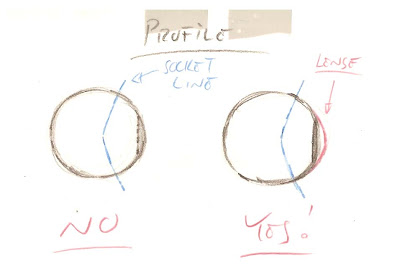 I don't necessarily always draw the lense, but I do draw the affects of it. Meaning, because your eye is not a perfect sphere there is friction on your eye lids. Your bottom and top lid with deform and bend slightly to the curve of your lense.
I don't necessarily always draw the lense, but I do draw the affects of it. Meaning, because your eye is not a perfect sphere there is friction on your eye lids. Your bottom and top lid with deform and bend slightly to the curve of your lense.Below here in this pic see how the curve of the lid's follows the direction of the pupil. Not only is it what is physically accurate, but it also creates interest in the shape of the eye. A very basic drawing/design rule is uneven shapes. It's a very simple way to create dynamics, tension, a feeling of movement and life.
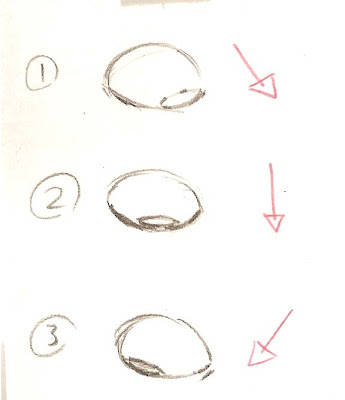
Speaking of pupil direction, check out this page below. In extreme up or down shots (imagine the eye is in a general looking straight position) how you draw the eye is important. Remember that the pupil and cornea are not on the surface of the lens. It's beneath the lens. If you flip your eye from the right to left rows you'll see the difference between a pupil that is "painted" on a flat surface verses the pupil that is set beneath the lens. You'll notice on the profile I didn't draw the literal lens sticking out from the eye. It's a matter of taste/and style sometimes.
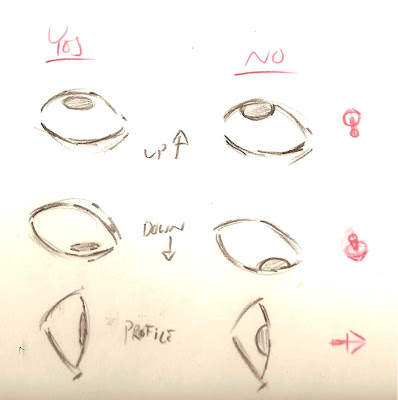
As I said before a basic design and drawing rule is to keep your shapes a-symmetrical . This creates interest in your shape. In this case below make sure your shapes are not straight and boring, but also that the pupil direction is reflected in the overall shape of the eye.
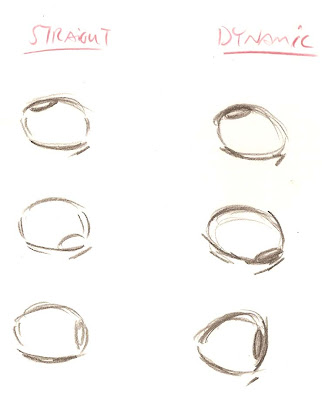 This pic below is just to show you where and how the muscles connect to the eye. This is more important to inform how you animate your eyes than it is how you draw them. Notice how short those muscles are? Short muscles mean quick contraction which translates into eye darts. That's why your eyes move so fast. The eyes can move slowly, but it's not as often. Like everything, it's a matter of taste in the moment of choice.
This pic below is just to show you where and how the muscles connect to the eye. This is more important to inform how you animate your eyes than it is how you draw them. Notice how short those muscles are? Short muscles mean quick contraction which translates into eye darts. That's why your eyes move so fast. The eyes can move slowly, but it's not as often. Like everything, it's a matter of taste in the moment of choice.
Lastly, the thing to know about eyes is that their shape is created by the lids surrounding the eye ball. Not the eye ball itself... check out these pics of different people and note what kind of impression they give you as a viewer based on their shape.




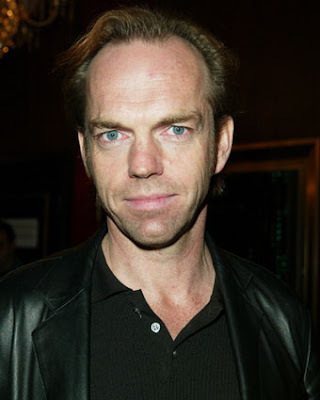



I cannot communicate how important eyes are. Yeah yeah, we all know that you say, but really man! If they are the first thing we look at they must say some something pretty important to us as people. A lot of what I covered today was more on the technical "how to" end of things, but you gotta know this stuff to get to the artful parts of it all. Next post I'll post some screen shots from live action and animated performances that I feel uses eyes to their potential. Until then, thanks for hanging in there and reading all of this!
Wednesday, March 21, 2007
Eye, Eye Cap'N!
Monday, March 12, 2007
Check it! YO!

(A young John Lasseter... haha, no joke!)
Check out this link:
http://phx.corporate-ir.net/VirtualPlayerFST.zhtml?c=129198&EventId=1486224&WebCastId=623469&StreamId=859281&id=&IndexId=&EID_TIK=&RGT=&RGS=&CTID=
Click on the section that says "Animation Overview"... it's worth it.
Pretty neat stuff man... Actually, more like a dream come true! I just don't sleep anymore man! Here I am writting this at 2 in the morning when I should be sleeping! But I can't, the dream is back...
Tuesday, March 06, 2007
just for fun
hand drawn animation on Vimeo
No thoughts this time round' or anything good to say. Just a very short shot I did from Curious George. This one took like, 3 days-- was fun cuz of the camera move. Always enjoy a good camera move shot!
I try to get a good mix of physical shots and acting shots in a film, even though physical shots invovle acting and acting shots involve physicality. Ooops, more depth than i said i was gonna have for this post... Enjoy!
Thursday, February 15, 2007
are you an Actor, or a Technician?
 (I add this pic because it's guys like this that have inspired
(I add this pic because it's guys like this that have inspiredthe thought to this post)
We all have to come to a point in our artistic lives where we sit down with ourselves and have a very brutally honest heart to heart. We have to ask ourselves "Am I REALLY an actor/artist, or am I just a good technician?"
It's painful... growth, however necessary can be extremely painful at times. Growth shows us where we were/are weak, and sometimes it's embarrasing that we didn't see how weak we really were/are at the time. I bring this up because i feel like being vulnerable is a key elemant to personal growth but also the growth of others around you. We have to be honest with ourselves: are we really good actors, or can we just convincingly move stuff around. Understanding good weight, spacing, drawing things well or even convincingly ISN'T ENOUGH. It's something i feel like exists a lot today unfortunately (animation that is merely technically pleasing)... I wish i could say i have not contributed to it. There are so many animators out there (and I am talking specifically hand drawn although this does not solely apply to the hand drawn animation) that are very technically sound animators who blow you away with there tech. prowess. They understand drawing, and spacing, control their volumes well, blah blah blah. But they don't tell you jack squat about the characters they are performing. They don't THINK about their characters, instead they overindulge in squash and stretch, through in fancy smear drawings, flaunt their beautiful arcs... all at the price of a better pose that could have told you something important.
I think this can be partially attributed to the fact that we as a generation stand on a lot of brilliant work from the past guys to look at and be inspired by. And if you're like me you could sit around all day staring at Milt or Frank drawings/animation. It's our blessing and our curse-- we subconciously revert to what we know will work, we play it safe. That's how acting patterns begin, and cold sterile art is born. Ironically the old guys had NOTHING to look at (animation wise) and found their inspiration from life or other areas of art.
This is a tough thing to do (not copy the past)-- I am not just talking to students, I am talking to every animator: Pro, amateur, retired vet, whoever... no once escapes this question. But here's the GOOD news, no one has to create only technically pleasing art. You absolutely can create a moving performance. YOU have something special to say in a way that only YOU can say it. That is what will set you apart... the challenge is can you call a spade a spade and realize that maybe you've just been a good technician all these years/months/whatever! I know I had too and still daily ask myself why i am doing what i am doing.
I share all these thoughts not to discourage and get down on anyone, but to encourage everyone that they can be amazing! The trick is are you willing to look at yourself in the harsh light of day and really ask yourself this horribly honest question? I know if i want to do something special with my art, I have to every single day. NOW GO KICK SOME BUTT!
Wednesday, February 07, 2007
Eye Darts and the Social Triangle
More than how you pull it off though is WHY you pull it off. I've never had a director tell me this but i have had friends that have told me some directors will just tell them as they are finishing their shots, "looks great, now throw some eye darts in there and it's done!" OK, but ummmm, why? The funny thing is that when i do it in hand drawn most directors ask me to take them out. Weird--
There are many different feelings about eye darts-- Some people say they weaken the character, some people say without them the character looks dead. You can always go too far in either direction so I lie somewhere in the middle. It's always about the story your telling-- as an animator you tell stories in Micro form, shot by shot. There may be a time when a character is tense and very serious about something. That could be a time to hold those eyes still, like laser focused! Remember ever being yelled at by someone who was dead serious and they lock eyes with you so you know they are not kidding? That's what I'm talking about--
Sometimes though your character might need to be pondering something or reading someones expression. This is where the social triangle comes in. I thought a great way to teach this would be by looking at someone with the body of a greek god, and the face of an angel. It was an easy choice--
 OK, soooo-- Social Triangle. It's exemplified below as the the first things we look at on other people to read how they are feeling about us, about themselves, what they are thinking... just reading them in general.
OK, soooo-- Social Triangle. It's exemplified below as the the first things we look at on other people to read how they are feeling about us, about themselves, what they are thinking... just reading them in general. Generally when i do eye darts, especially in conversation bits, I dart them back and forth from left to right. If the character is right handed I start on the other characters right eye and work to the left and back again. If the character is left handed I will do the exact opposite--
Generally when i do eye darts, especially in conversation bits, I dart them back and forth from left to right. If the character is right handed I start on the other characters right eye and work to the left and back again. If the character is left handed I will do the exact opposite--The last thing we read on the face is the mouth. So at times i will alternate down slightly in between the left to right motion.
The thing about this stuff is knowing when to use them-- I love qoutes and I'm gonna butcher this one but it's a really neat one my friend Tony DeRosa told me. He said Mark Twain said this about writting, "The difference between finding a good word and the exact word to explain something is like the difference between a firefly and a lightening bolt!" What's that have to do with eye darts? well, eye darts aid in acting, and (an animation as a whole) is about distilling life to it's essence. When you see a good caricature of someone, it might take you a minute to get it then you forget it. But when you see an Al Hirschfield caricature it's like that lightening bolt man! It hits you because he's captured the essence of the person. Acting should capture the essence of the feelings of the moment. Eye Darts are one of the many tools to help you do that. This little post was more just to explain why and how to use them-- hope it helps!





